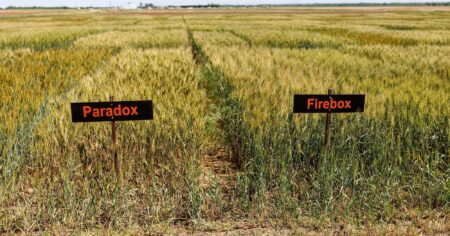Editor’s Note: This is the first in a series of four articles highlighting the contributions farmers and their machinery made to winning World Wars I and II. These articles originally appeared in Ageless Iron Almanac in 2015 and 2016.
Much has been said of the contribution technology made to the winning of wars, particularly World Wars I and II. Rarely do war historians acknowledge one of the most powerful weapons our country deployed during these conflicts, though.
“Truly,” said Rod Reding, producer of Ageless Iron TV, “agriculture became our country’s secret weapon in winning the wars.”
Ramping up for War
The onset of World War II in 1939 was viewed as a mixed blessing by farmers. They knew they would do their part to support their country if it went to war. Yet, they also feared the loss of life, particularly their sons.
In September 1941, then-Secretary of Agriculture Claude R. Wickard called for “the largest production in the history of American agriculture to meet the expanding food needs of this country and nations resisting the Axis.”
Soon, people began speaking of Food for Defense, and Agricultural Adjustment Administration officials began meeting with farmers, urging them to increase production.
The need for more food became a certainty on December 7, 1941, when Japan’s military attacked Pearl Harbor. By this time, farmers and machinery manufacturers faced a daunting challenge.
The drain on the components to make machinery, especially steel, was almost entirely being diverted into manufacturing war material. The impact was immediate. Tractor and implement shortages quickly developed.
The experimental development of tractors was all but nonexistent during the war years. Just six new models were introduced, mostly based on prewar designs.
Making Adjustments
Farmers soon adapted to the lack of new machinery by repairing breakdowns to extend implement life and by sharing with neighbors when an implement wore down.
“This is more than a question of neighboring – it is a question of patriotic service for the country,” noted H.O. Davis, rationing director for Kansas.
Farmers couldn’t repair, share, or innovate their way out of the shortage of labor created as their sons and hired hands went off to war. Creative minds soon conjured up a number of solutions.
Birth of Custom Cutters
Cory Hall
For example, itinerant harvest crews were formed to harvest small grain en masse across the High Plains. This birthed what we know today as custom cutters.
Massey-Harris, who had just introduced one of the first successful self-propelled combines, contributed by creating the Harvest Brigade after being given the go-ahead by the government to make 500 combines. Four months and over 1,500 miles later, this self-propelled assault had covered seven states, consuming over 1 million acres of crops, harvesting 25 million bushels of wheat and other grains. Doing this saved the nation 300,000 man hours and 500,000 gallons of fuel.
Women, particularly farm girls, also stepped in to fill the labor void assisted by programs that trained them to operate and repair equipment.
In February 1943, Secretary of Agriculture Wickard asked the Extension Service to develop an effort to recruit women for farmwork. Programs such as the Farmettes and Tractorettes offered needed training on how to tend livestock, operate a tractor, and repair machinery.
Women’s Land Army
Provided by Wisconsin Historical Society
The creation of the Women’s Land Army (WLA) in 1943 as part of the Emergency Farm Labor Program and the U.S. Crop Corps failed to attract women from the city. So in October of that year, farm women became eligible to join the organization.
From that point until the termination of the WLA in 1945, as many as 2 million women became part of that effort. While agriculture’s needs were being met with labor innovations, farm machinery manufacturers re-created themselves to make military equipment.
The vast bulk of plant capacity was focused on making material ranging from bullets to guns and engines to transmissions for vehicles. Existing tractor models were remade to serve as transport vehicles, primarily airplane tugs.
The bulk of tractors’ contributions to the war came through the use of crawlers employed to build airfields, battlements, or depots. Caterpillar and IHC’s TracTracTor crawlers, for example, saw extensive action under fire in the Pacific theater.
Tractors also contribute to the creation of war machines besides those used in construction.



:max_bytes(150000):strip_icc()/heatherlibrary-90ea3b4777294b008ffd3f817bf229d5.jpg)
:max_bytes(150000):strip_icc()/2308-01-097_pigs-b0529b97e3e943d392b7014aee9eb4f5.jpg)


:max_bytes(150000):strip_icc()/massey-harris-100014203-54050dd49f6b47c781a7b3166f1b73b7.jpg)
:max_bytes(150000):strip_icc()/DC-5ec71dd349104ec287b318f05ebf5f74.jpg)
:max_bytes(150000):strip_icc()/SFCE_Sp25_WortheyFarmersMarket_preview1-9c3c0b2c5e9444249fa60594b7f30fec.jpg)
:max_bytes(150000):strip_icc()/TaylorsFireworkssign-c3dd3eb41cc646c593dbebfee850bdc0.jpg)
